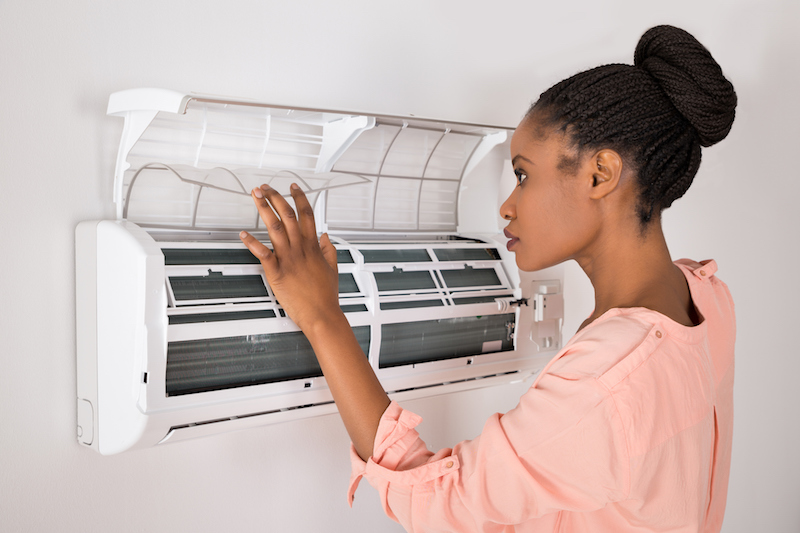
You shouldn’t need to compromise on comfort or drain your wallet to keep your residence at a refreshing temperature during summer weather.
But what is the ideal setting, exactly? We go over advice from energy professionals so you can select the best temp for your home.
Here’s what we recommend for the most energy-efficient setting for air conditioning in Shamokin and Sunbury.
Recommended Thermostat Settings for Summer
Most families find placing the thermostat at 72-73 degrees is ideal. However, if there’s a big difference between your indoor and outside warmth, your electricity expenses will be larger.
This is our advice based on the U.S. Department of Energy (DOE) and ENERGY STAR®.
While at home: 78 degrees. While that seems hot, there are ways you can keep your house pleasant without having the air conditioner on frequently.
Keeping windows and window treatments down during the day keeps chilled air where it needs to be—indoors. Some window treatments, like honeycomb shades or plantation shutters, are designed to provide more insulation and improved energy savings.
If you have ceiling fans in your home, the DOE says you can increase thermostat temps about 4 degrees warmer without giving up comfort. That’s because they refresh with a windchill effect. Because they cool people, not rooms, switch them off when you exit a room.
If 78 degrees still feels too uncomfortable initially, try conducting a trial for a week or so. Begin by raising your temperature to 78 degrees while you’re at your residence. Then, gradually decrease it while adhering to the suggestions above. You could be shocked at how refreshed you feel at a warmer temperature setting.
While away: 88 degrees. There’s no reason to keep the air conditioning going all day while your home is unoccupied. Turning the setting 7–10 degrees hotter can save you as much as 5–15% on your air conditioning costs, according to the DOE.
When you arrive home, don’t be tempted to put your thermostat under 78 to cool your home more rapidly. This isn’t effective and typically results in a more expensive air conditioner bill.
A programmable thermostat is a helpful approach to keep your temperature controlled, but you have to set programs. If you don’t set programs, you run the risk of forgetting to raise the set temperature when you take off.
If you’re looking for a hassle-free solution, think over installing a smart thermostat. This thermostat works with with your phone, so it realizes when you’re at home and when you’re out. Then it intuitively modifies temperature settings for the biggest savings. How much exactly? About $180 annually on heating and cooling, according to ENERGY STAR.
Another plus of having a smart thermostat? You can use your phone to watch and change temperature settings from nearly anywhere.
While sleeping: Around 70 degrees. While ENERGY STAR advises 82 degrees, that may be unpleasant for the majority of families. Most people sleep better when their bedroom is chilly, so that’s why the National Sleep Foundation recommends 60–67 degrees. But that could be too cold, based on your pajama and blanket preference.
We suggest following an equivalent test over a week, setting your thermostat higher and slowly lowering it to find the best temp for your house. On pleasant nights, you could learn keeping windows open at night and using a ceiling fan is a preferable idea than operating the AC.
More Methods to Save Energy During Warm Weather
There are extra approaches you can save money on cooling bills throughout hot weather.
- Buy an energy-efficient AC system. Central air conditioners only work for about 12–15 years and lose efficiency as they get older. An updated air conditioner can keep your residence cooler while keeping utility costs low.
- Set yearly air conditioner service. Regular air conditioner maintenance keeps your equipment operating like it should and may help it work at better efficiency. It may also help prolong its life cycle, since it helps pros to discover little problems before they lead to a major meltdown.
- Switch air filters regularly. Use manufacturer instructions for replacing your air filter. A clogged filter can result in your system short cycling, or turn on and off too often, and raise your cooling.
- Check attic insulation levels. Nearly 90% of homes in the USA don’t have enough insulation, according to the Insulation Institute. Most southern climates require 13–14” of attic insulation, while northern climates require 16–18”.
- Have your ductwork inspected. Ductwork that has separated over time can seep conditioned air into your attic, walls or crawl space. This can create big comfort issues in your house, such as hot and cold spots.
- Seal holes, doors and windows. Keep hot air where it should be by sealing cracks. You can also caulk or weather strip doors to seal more conditioned air indoors.
Save More Energy This Summer with LTS Plumbing & Heating Inc.
If you want to use less energy during warm weather, our LTS Plumbing & Heating Inc. professionals can provide assistance. Give us a call at 570-648-0748 or contact us online for more information about our energy-saving cooling options.
